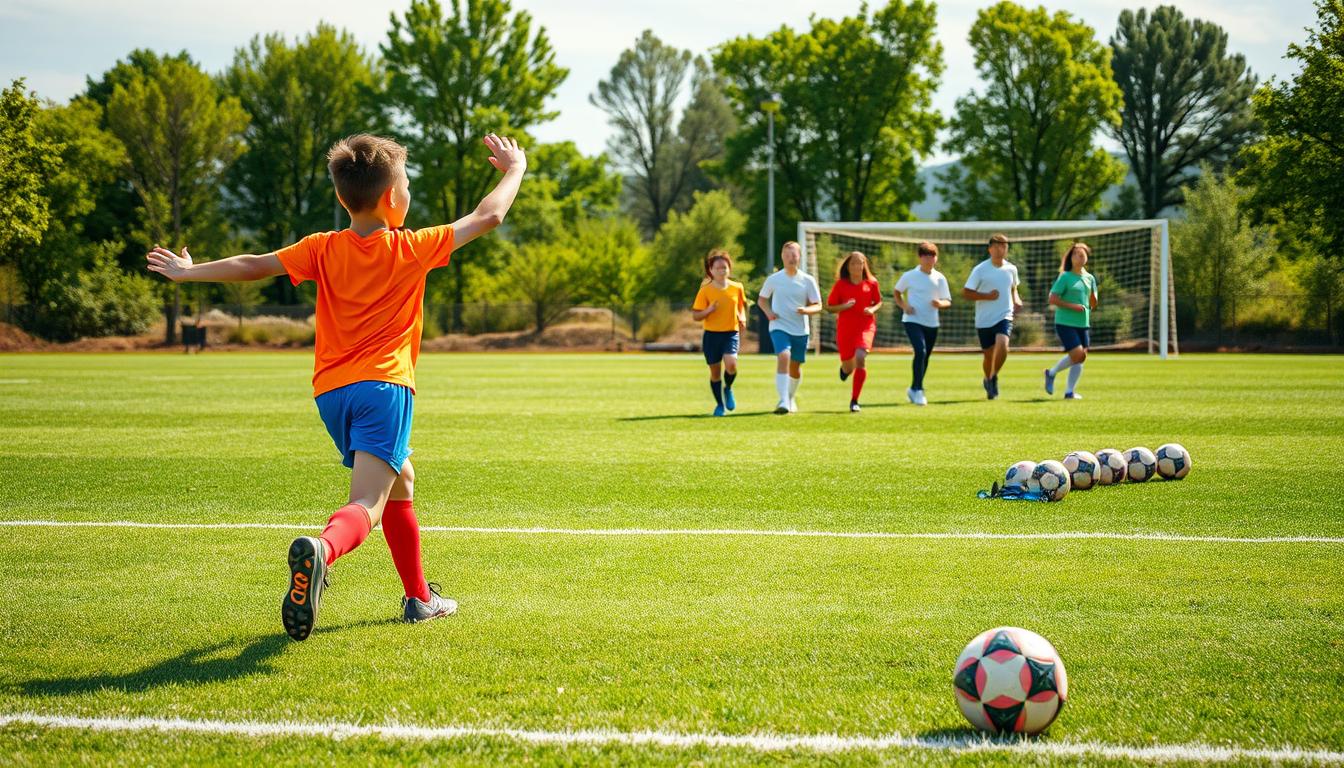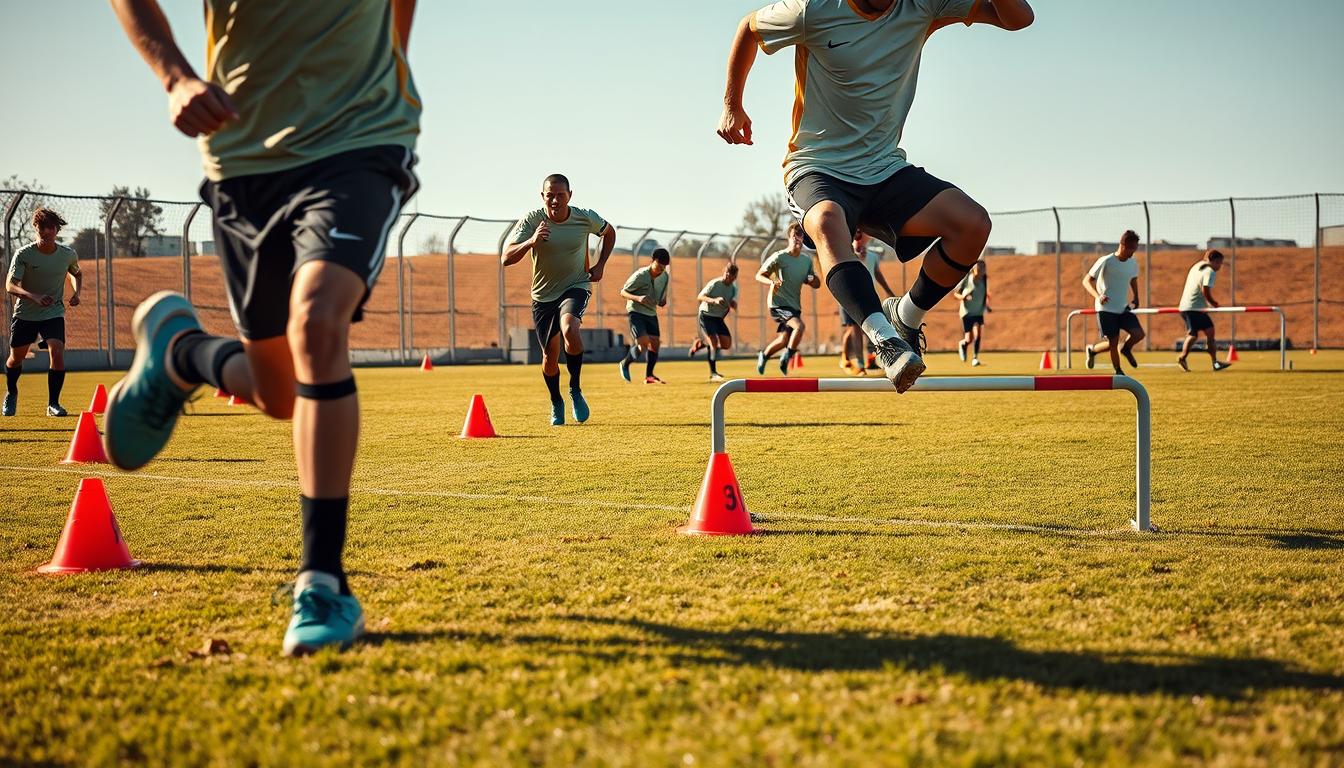Fitness Tips for Beginner Soccer Players

Ever wonder why some athletes dominate the field while others struggle to keep up? Your performance hinges on more than just ball control – physical readiness separates casual participants from impactful competitors. Building stamina, agility, and strength isn’t just about looking like a pro; it’s about lasting through intense matches and avoiding setbacks.
This guide breaks down the five essential elements every new athlete needs. You’ll learn how targeted exercises boost coordination, speed up recovery, and sharpen your technical abilities. Better yet, you’ll discover strategies to stay game-ready all season without burnout or injuries holding you back.
Key Takeaways
- Physical conditioning directly affects how long and how well you perform during matches
- Speed and agility training enhances your ability to react quickly during gameplay
- Proper warm-ups and cool-downs reduce injury risks by over 40%
- Stamina-building exercises help maintain energy levels through overtime periods
- Strength training supports better ball control and powerful kicks
Understanding the Basics of Soccer Fitness
Modern matches demand more than just kicking a ball. They require your body to handle constant shifts between explosive bursts and steady movement. This unique blend makes soccer-specific conditioning different from regular workouts.
What Makes Soccer Conditioning Unique
During a typical game, you’ll cover over five miles through varied movements. Only 10% involves straight sprints – most quick bursts last under 20 meters. Your training should mirror these patterns. Focus on:
- Cardiovascular endurance for sustained energy
- Short-distance speed drills
- Multi-directional agility work
These elements help you keep pace during critical moments. Unlike marathon runners, soccer athletes need stop-start stamina. This lets you chase opponents, then recover quickly for the next play.
Building Through Repetition
Consistent practice creates muscle memory. Regular sessions improve how your body uses oxygen and processes lactic acid. Over time, you’ll notice faster reaction times and cleaner passes during tired moments.
Structured routines also prevent plateaus. Mixing skill-building drills with fitness work strengthens both physical and technical abilities. Remember – progress happens through small, daily improvements rather than occasional intense efforts.
Beginner soccer fitness tips: Building Your Cardio Foundation
Your engine on the field relies on smart conditioning. Unlike steady-paced activities, soccer demands rapid switches between explosive moves and brief recovery periods. Let’s break down two proven methods to boost your stamina and speed.
Effective Sprint Intervals
Interval training mirrors real-game energy bursts. Try this drill: sprint 20-30 meters at full intensity, then rest 30-60 seconds. Repeat 15-20 times. This builds the quick recovery ability needed after chasing opponents or making decisive plays.
| Exercise Type | Work Phase | Rest Phase | Repetitions |
|---|---|---|---|
| Sprint Intervals | 30 seconds | 60 seconds | 8-12 |
| Steady Runs | 20 minutes | N/A | 3-4 weekly |
Enhancing Endurance with Steady Runs
Longer runs at moderate pace teach your body to conserve energy. Start with 15-minute jogs three times weekly, increasing by 5 minutes every two weeks. Focus on nasal breathing to optimize oxygen flow.
Combine both methods for balanced conditioning. You’ll notice sharper movements during critical late-game moments when others slow down. Track progress by timing how quickly your heart rate returns to normal after intense drills.
Strength Training Essentials for Soccer Success
Your lower body holds the key to unlocking next-level performance. Targeted workouts build the explosive force needed for powerful kicks and rapid direction changes. Let’s explore how to develop this critical athletic trait safely and effectively.
Foundation Builders: Squats & Deadlifts
Barbell squats and deadlifts form the core of any solid program. These movements engage multiple leg muscles simultaneously, mimicking the demands of gameplay. Start with 3 sets of 6 reps using moderate weights – focus on controlled movements rather than max loads.
| Exercise | Sets | Reps | Focus Area |
|---|---|---|---|
| Barbell Squat | 3 | 6 | Quadriceps/Glutes |
| Single-Leg Squat | 3 | 12 | Balance/Stability |
| Squat Jumps | 3 | 30 sec | Explosive Power |
Power Amplifiers: HIIT & Plyometrics
Combine strength work with high-intensity intervals for maximum results. Alternate weighted lunges with 20-second sprints to build game-ready stamina. Plyometric drills like box jumps improve your vertical leap – crucial for headers and contested plays.
Always prioritize proper form. Keep your chest up during squats, and drive through your heels when jumping. Gradually increase weights by 5-10% weekly as your muscles adapt. This progressive approach prevents plateaus while reducing injury risks.
Strong legs translate directly to on-field advantages. You’ll notice quicker accelerations, higher jumps, and more powerful shots within 4-6 weeks of consistent training. Pair these workouts with agility drills for complete athletic development.
Agility and Mobility Drills to Enhance Game Performance
Sharp turns and rapid footwork decide games more than raw speed. These agility drills train your body to shift directions like a pro while maintaining control. Pair them with mobility work to protect your joints during explosive movements.

Agility Ladder and Cone Exercises
Start with the lateral in-and-out drill. Face the ladder sideways, quickly tapping both feet in each square as you move forward. Keep these tips in mind:
- Stay on the balls of your feet for faster reactions
- Add a ball dribble after mastering foot patterns
- Complete 3 sets of 20-second bursts
Cones build game-like direction changes. Try these setups:
| Drill | Setup | Purpose |
|---|---|---|
| W Drill | 5 cones in W shape | Sharp angle cuts |
| Short Shuttle | 3 cones, 5 yards apart | Acceleration control |
| Square Drill | 4 cones forming a box | 360° awareness |
Basic Mobility Moves for Injury Prevention
Healthy hips prevent knee strain. Try lying hip rotations:
- Lie on your back with knees bent
- Cross right ankle over left knee
- Gently push left knee outward 10 times
- Switch sides and repeat
Perform these mobility exercises before practices. They’ll keep your joints fluid during sudden stops and pivots. Pair them with dynamic stretches for full-body readiness.
Nutrition and Hydration for Peak Performance
What you eat and drink acts as your secret weapon during matches. Smart food choices keep energy steady and help muscles recover faster. Let’s explore how to build meals that work as hard as you do.
Planning Balanced Meals
Start your day with oatmeal topped with berries and a boiled egg. This combo delivers slow-release carbs and protein to fuel morning drills. For lunch, try grilled chicken with brown rice and roasted veggies – it provides fiber for digestion and nutrients for repair.
| Meal Time | Food Choices | Key Benefits |
|---|---|---|
| Breakfast | Oatmeal + fruit + nuts | Sustained energy |
| Lunch | Salmon + quinoa + greens | Muscle recovery |
| Snack | Greek yogurt + banana | Quick protein boost |
Evening meals should include lean proteins like turkey or fish. Add avocado slices for healthy fats that reduce inflammation. Snack on almonds between meals to maintain energy without feeling heavy.
Importance of Daily Water Intake
Three liters of water daily keeps your reaction times sharp. Dehydration causes a 20% drop in decision-making speed – enough to miss a critical pass. Carry a reusable bottle and sip every 15 minutes during practice.
Electrolyte tablets help on intense training days. Avoid sugary sports drinks – they cause energy crashes. Your urine should stay pale yellow throughout the day, especially before evening sessions.
Smart Recovery and Injury Prevention Strategies
Did you know your body repairs itself fastest within 30 minutes after training? This golden window makes recovery tactics just as vital as drills. Proper care keeps you performing at peak levels while reducing downtime from strains or fatigue.
Effective Stretching and Foam Rolling
Dynamic stretches work best after workouts. Try leg swings and torso twists to maintain flexibility. Hold each move for 15 seconds – this helps flush lactic acid from tired muscles.
Foam rolling breaks up tight spots in your legs and back. Follow this weekly plan:
| Body Area | Duration | Frequency |
|---|---|---|
| Calves | 2 minutes | Daily |
| Hamstrings | 90 seconds | Post-training |
| Upper Back | 1 minute | Rest days |
Sleep fuels muscle repair. Aim for 7-9 hours nightly. Dark, cool rooms boost sleep quality. Track rest patterns using free apps to spot improvement areas.
Listen to your body’s signals. Persistent soreness or irritability suggests needing extra rest days. Swap intense drills for light walks or yoga until energy rebounds.
Skill-Enhancing Drills and On-Field Exercises
Precision in movement separates average plays from game-changing moments. Combining technical development with physical conditioning creates athletes who outmaneuver opponents effortlessly. These methods build the sharp reflexes needed to execute complex moves under pressure.
Footwork Patterns for Precision Control
Try the three-cone dribble drill to sharpen direction changes. Set cones five yards apart in a straight line. Dribble through them using only your dominant foot’s instep, then repeat with your weaker side. Focus on:
- Keeping the ball within arm’s reach
- Quick taps rather than powerful kicks
- Head up to simulate game awareness
This exercise improves touch accuracy while building calf endurance. Time yourself weekly – aim to shave two seconds off your best mark through cleaner foot placement.
Coordination-Building Challenges
Partner passing drills enhance spatial awareness. Stand 10 yards apart and pass while moving laterally. Add these progressions as skills develop:
| Level | Drill Variation | Focus Area |
|---|---|---|
| 1 | Two-touch passes | First-time accuracy |
| 2 | One-touch only | Reaction speed |
| 3 | Add defensive pressure | Decision-making |
You’ll notice cleaner first touches during matches after three weeks of consistent practice. Pair these sessions with ladder agility work to reinforce neural pathways between your feet and brain.
Wrapping Up Your Soccer Fitness Journey
Your progress on the field reflects the effort you put into every workout and recovery session. Combining cardio, strength sessions, and mobility drills builds the complete athletic toolkit needed for match days. Studies show 12 weeks of focused strength work can boost sprint speed by 15% while cutting injury risks.
Adjust your training intensity as the season progresses. Lighter agility drills during game weeks preserve energy, while off-peak periods let you push limits in the gym. Track improvements like faster recovery times or increased pass accuracy – these small wins fuel long-term growth.
Set specific goals aligned with your role, whether mastering 90-minute endurance or sharpening side-step reactions. Remember, top athletes refine their skills through consistent practice, not overnight transformations. Celebrate each milestone, then identify your next challenge.
Keep evolving your routine as your abilities grow. Pair dedicated training with smart rest days to maintain peak performance year-round. The journey to becoming a stronger, more resilient player never truly ends – it just gets more rewarding.
